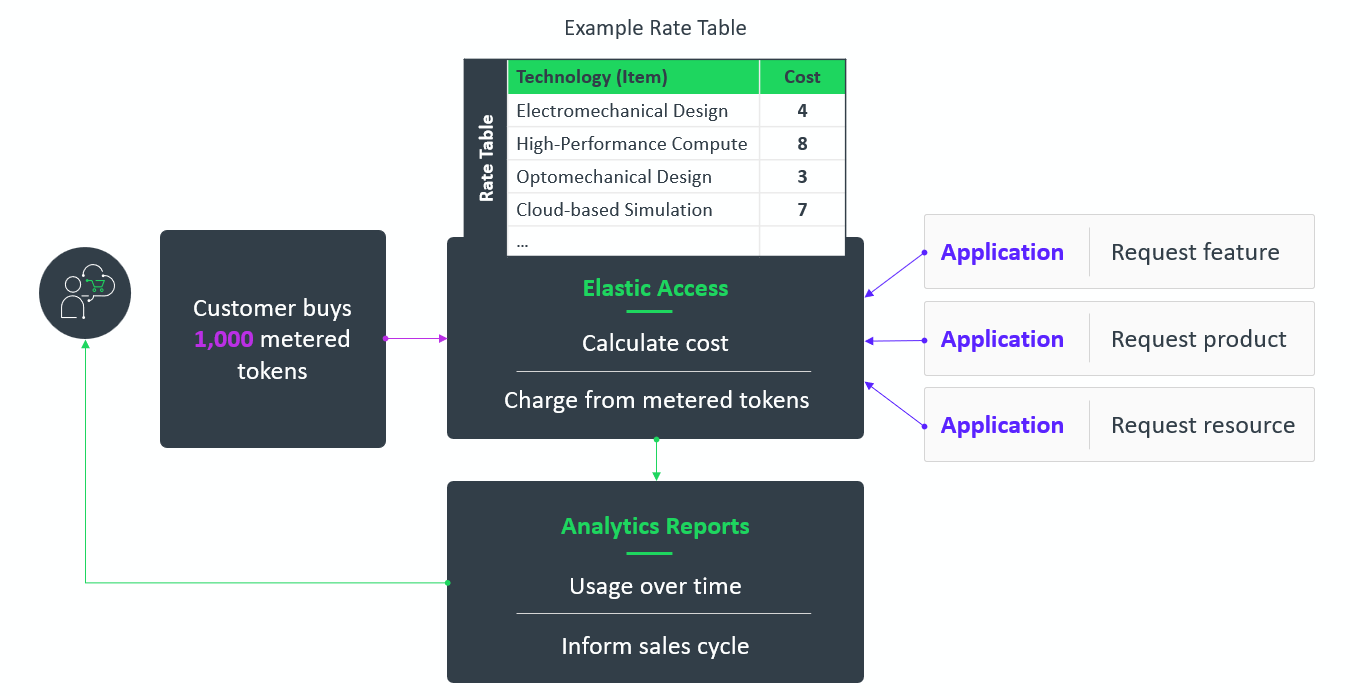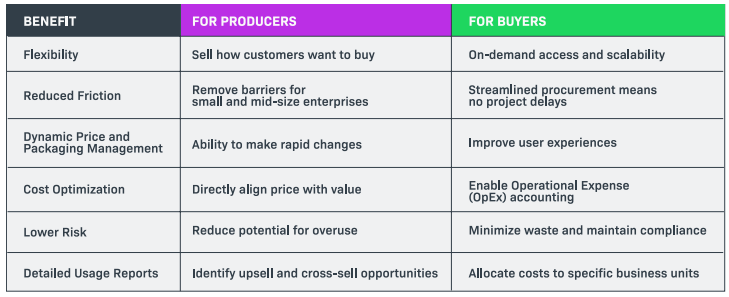eBook
How to Modernize Your Software Business with Elastic Access
The Dynamic Monetization Series
What is Elastic Access?
Revenera’s Dynamic Monetization is an API-driven cloud service that allows technology companies to introduce flexible monetization models for connected software and devices. It allows rapid price and packaging changes via adjustable rate tables and real-time usage data.
Elastic Access is a modern, pay-per-use model available through Dynamic Monetization. It’s highly practical for products and services that have fluctuating usage patterns, allowing end customers to increase volume whenever necessary, such as for specific projects, seasonal peaks, or short-term, occasional use.
Token Terminology
Technology companies that embrace pay-per-use models often coin creative ways to describe their currency. While some may say prepaid or flexible credits, others prefer terms such as metered or consumptive tokens.
Ultimately, no matter how you refer to your Elastic Access units, this is a credit-based drawdown model whereby customers purchase a set amount of credits upfront, which can be exchanged for immediate access to your portfolio.
Dynamic Monetization and Elastic Access: Explained
Paul Bland explains how you can enable pay-per-use pricing with Revenera's Dynamic Monetization service and unique Elastic Access monetization model.
The Value of Elastic Access
Elastic Access removes barriers to adoption, enables cross-portfolio access, and supports advanced monetization models by allowing you to:
- Sell metered tokens (aka flexible credits), which customers can exchange to access any offering within the portfolio.
- Set prices for each item (application, feature, capability, computation, service, etc.) in a rate table.
- Make immediate pricing and packaging changes by adjusting the rate table.
- Provide real-time, granular usage data to ensure exact charging.
Match Capacity with Demand
Elastic Access complements subscription models, as customers benefit from the ability to instantly scale capacity when needed.
Common usage scenarios include producers enabling on-demand access to a broad suite of applications – potentially charging different rates for each – or HPC (High Performance Computing) platforms that can instantly scale upon request.
How Elastic Access Works
- Your customer buys an entitlement for a set number of prepaid credits.
- Credits are immediately available, allowing customers to request items from the rate table, enabling greater control over how your portfolio is accessed.
- The cost of use is calculated; and tokens deplete accordingly. Charges may either apply on a per-use basis or repeat at a fixed rate over time (such as four tokens per hour).
- Each charging event is pushed to the data warehouse in real-time. This allows technology companies to produce analytics to illustrate usage patterns, build reports to help customers understand and allocate software spend, and gain actionable data to identify upsell and cross-sell opportunities. Data can also inform product roadmap decisions.
- Engage in more insightful conversations with your customers at renewal time.

USE CASE
Cross-Portfolio Access
The flexibility of Elastic Access means that users can try a software producer’s full portfolio of software offerings, using a new application or a new feature within an existing application, without having to buy a specific product license. Experimentation with the portfolio allows customers to learn about the full range of offerings from a producer, becoming more engaged with the brand. This can be especially useful for small- and medium-sized enterprises (which may not be able to allocate spend for a large portfolio) and for customers that find demand surges difficult to predict and expensive to purchase through formal subscriptions, which can result in unused licenses.
As Elastic Access rate tables are easily configured, you can lower the barriers to adoption and allow customers to dip in and out of applications within your portfolio. Customers who have already bought prepaid credits can make the operational decision of selecting the software that’s best suited to their current needs, perhaps due to seasonal or project-based requirements, or simply to try an application they haven’t previously used. No longer are they limited to a single product or feature, but can access what they want, when they need it.
Cross-portfolio access, made possible by Elastic Access:
- Reduces friction in the sales process.
- Provides the ability to tailor offerings to diverse customer segments and budgets.
- Delivers cost optimization opportunities, ensuring customers only pay for what they use.
- Provides detailed usage reporting, with cost allocation to specific business units.
- Automates expiration and usage threshold alerts.
- Matches capacity with demand.
- Facilitates cross-sell opportunities.
USE CASE
Pay-Per-Use Premium Features
How do you give your customers friction-free access to your premium features? Traditionally this might have been achieved via a premium packaging approach, with top-level grouping of features, and negotiated contracts for smaller numbers of the most expensive packages. Selecting which features belong to what package certainly needs careful thought and planning. The consequence of this complicated approach is often missed upsell opportunities.
Elastic Access simplifies the process of letting customers engage with your premium features. Premium features can be factored into the rate table as add-ons to the main software; their use is charged at the appropriate rate, and easy access enhances the experience. Any number of add-ons can be provided in this way, and giving customers the chance to try before they buy can create productive upsell conversations.
Identify Upsell Opportunities
- Make sure that customers know about your premium products/features.
- Make it easy for customers to access your premium products/features without the need for lengthy negotiations.
- Track usage insights to inform future sales conversations.
USE CASE
Introduce New SaaS Offerings
SaaS promises the seamless rollout of new capabilities through continuous updates.
Elastic Access supports the seamless rollout of the revenue benefits of SaaS.
With other approaches to software monetization, rigid pricing structures make it difficult to respond to customer requirements. Lack of data also makes it difficult to track how the software is being used. This lack of data centrality prevents the analysis to support agile business decisions.
With Elastic Access, new offerings can be made available to customers quickly. The data it provides about token consumption allows immediate insight into usage and levels of longer-term adoption. This usage data assists with renewals and sales forecasts.
Elastic Access, used for introducing new SaaS offerings:
- Supports rapid delivery of new pricing and packaging options.
- Accelerates time-to-value for customers, with minimal provisioning support from IT or engineering teams.
- Improves renewals forecasting, due to increased visibility into engagement and adoption.
- Facilitates expansion into new markets through increased flexibility, resulting in increased profitability and company valuation.
Six Benefits of Elastic Access

USE CASE
Agile Product Monetization
Not knowing how customers are using products, features or services means that the impact of product changes is not known without individual discussions with customers, and opportunities are missed for growth within and beyond your target market.
A long lead time for packaging changes can result in sprawling SKU catalogs in attempts to provide variations, and a long sales cycle as customers wade through the possibilities, trying to find the right thing to meet their business problem.
Most Product Managers need a quick way to see the result of changes made to products, in order to be agile not only in product development but also in its monetization.
Elastic Access provides quick feedback on the way changes made interact with customer preferences – because every consumption event is reflected real-time in the data warehouse.
With the flexibility of Elastic Access rate tables, SKUs can be managed (or simplified if necessary) with little effort.
The ease with which offerings can be added to the rate table allows accelerated speed-to-market, giving a fantastic competitive edge.
Elastic Access benefits you – and your customers
Aligning price with value is key for customer satisfaction and customer retention. Revenera’s Dynamic Monetization is built for high volume, rapid usage processing, as needed in many monetization models today. The real-time usage insights aid quick decision-making for rapid price and packaging changes, while also ensuring that costs are optimized for customers. The ability to create detailed usage reports also help producers identify upsell and cross-sell opportunities to grow Annual Recurring Revenue (ARR).
The Elastic Access model reduces friction, removing barriers to adoption that can be common for small and mid-size enterprises, allowing cross-portfolio access to a range of items on an as-needed basis rather than long-term, fixed-rate subscriptions. Customers benefit from instant scalability, streamlined procurement, and the ability to try new offerings without committing to long-term subscriptions.
With multiple benefits for both buyers and suppliers, Elastic Access goes a long way to aligning price with value, improving user experiences and driving long-term retention built on constant innovation.
Frequently Asked Questions (FAQs)
Elastic Access is a pay-per-use model that allows customers to purchase credits upfront and use them to access various software offerings. This flexible approach adapts to fluctuating usage patterns and enables rapid changes in pricing and packaging, making it ideal for modern software businesses.
Software producers can offer metered tokens, set dynamic prices, and provide real-time usage data. This enables advanced monetization models, cross-portfolio access, and the ability to instantly scale capacity based on customer demand, driving engagement and revenue growth.
Yes, Elastic Access complements traditional subscription models by allowing customers to scale their usage beyond base-level capacity. This ensures that users can access additional features or applications as needed, without being limited by fixed subscriptions.
Elastic Access is ideal for scenarios with unpredictable or seasonal demand, such as project-based work or cloud computing. It also supports cross-portfolio access, premium feature trials, and rapid introduction of new SaaS offerings, making it versatile for various business needs.
Customers benefit from friction-free access to software, the ability to try new features, and detailed usage reporting. This flexibility reduces procurement barriers and allows users to pay only for what they use, enhancing satisfaction and retention.
Elastic Access pushes real-time usage data to a data warehouse, enabling producers to analyze consumption patterns, build reports, and identify upsell or cross-sell opportunities. These insights inform product development and sales strategies.
With Elastic Access, product managers can quickly see the impact of changes and adjust rate tables with ease. This agility accelerates speed-to-market, simplifies SKU management, and provides a competitive edge in responding to customer preferences.
Absolutely. Elastic Access lowers adoption barriers, allowing SMEs to access a full software portfolio without committing to expensive, long-term licenses. This model supports cost optimization and scalability for businesses of all sizes.
Cross-portfolio access reduces sales friction, enables tailored offerings, and facilitates cost allocation to specific business units. It also automates alerts for usage thresholds and expiration, helping businesses manage capacity efficiently.
To implement Elastic Access, partner with a provider like Revenera and leverage their Dynamic Monetization platform. This enables you to configure rate tables, manage credits, and deliver flexible, scalable access to your software portfolio.
Resources
Webinar
AI Monetization Unlocked: Master Pricing Models and Plan for Market Success
Tuesday, January 27, 2026
Join IDC's Tiffany McCormick, Research Director, AI Monetization, Pricing Strategies, and Business Models and Revenera's Paul Bland, VP, Product Management to learn pragmatic ways to align price with value—and avoid the cost‑plus trap.
Webinar
Revenera Connect 2026: Boston
Wednesday, February 11
Webinar
6 Steps to Launching Usage-Based Pricing for SaaS and AI
Tuesday, February 17, 2026
In this webinar, Nicole Segerer, General Manager at Revenera, will share this practical 6-step framework for launching usage-based pricing in SaaS, AI, and even on-premises products.
Report
Rethinking Pricing: How to Choose Models That Reflect AI-Era Value
This best practice report produced by Forrester provides an overview of pricing models, their pros and cons, and considerations for implementation.
Webinar
SoftSummit 2026
April 28, 29 & 30 (Tuesday, Wednesday & Thursday)
Report
Monetization Monitor: Software Piracy and License Compliance 2026 Outlook
Revenera’s latest research report examines emerging trends in the prevalence and scope of unlicensed software usage and demonstrates how leveraging usage analytics or compliance analytics can enhance revenue recognition opportunities.
Want to learn more?
See how Revenera's Software Monetization platform can help you take products to market fast, unlock the value of your IP and accelerate revenue growth.